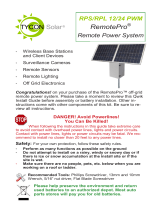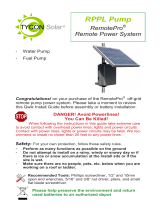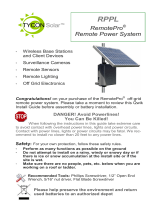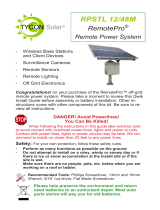Page is loading ...

RPPL-LG SCPOE
RemotePro® Outdoor
Solar Power System
▫ Wireless Base Stations
and Client Devices
▫ Surveillance Cameras
▫ Mission Critical Backup
Power
▫ Remote Sensors
Congratulations! on your purchase of the RemotePro® Outdoor
Off-Grid solar power system. Please take a moment to review
this Qwik Install Guide before assembly or battery installation.
DANGER! Avoid Powerlines!
You Can Be Killed!
When following the instructions in this guide take extreme care
to avoid contact with overhead power lines, lights and power circuits.
Contact with power lines, lights or power circuits may be fatal. We rec-
ommend to install no closer than 20 feet to any power lines.
Safety: For your own protection, follow these safety rules.
▫ Perform as many functions as possible on the ground
▫ Do not attempt to install on a rainy, windy or snowy day or if
there is ice or snow accumulation at the install site or if the
site is wet.
▫ Make sure there are no people, pets, etc. below when you are
working on a roof or ladder.
Recommended Tools: Phillips Screwdriver, Flat Blade Screw-
driver, 5/16 nut driver
Please help preserve the environment and return
used batteries to an authorized depot

2
Qwik Install
STEP 1: Prepare Enclosure - Attach Battery Brackets
Prepare the Velcro strap and the strap brackets,
#5600066. Orient as shown.
Loosen 8 screws holding the mounting plate.
Slide the mounting plate towards you and lift up
on the top end of the mounting plate while sliding
the #5600066 brackets with Velcro Straps over
the end of the mounting plate.
Place the brackets as shown (approx 1.75”
from the enclosure walls) and attach to the
mounting plate using Qty 4 #8 x 3/8 pan head
self tapping screws.
Tighten the Qty 8 mounting plate attach
screws.
Position the #5600067 Battery Support Brack-
ets ~7” from the top of the enclosure.
Attach to the mounting plate using Qty 6 #8 x
3/8 pan head self tapping screw. Note: The
farthest left and right screw holes won’t be
used.
Route the Velcro straps through the slot in the
#5600067 brackets. We recommend not in-
stalling the batteries at this time because it
makes the enclosure heavy and harder to handle. We suggest installing
the batteries once the enclosure is already mounted to a pole or wall.
STEP 2: Prepare Enclosure - Attach Pole Mount Brackets
Caution: Pole mount brackets may have sharp edges, wear gloves.
Attach the pole mount
brackets to the back of the
enclosure using four flat
washers as spacers under
the bracket and four flat
washers and self tapping
screws on top of the brack-
et per the instructions that
came with the enclosure.
STEP 3: Solar Battery

3
Charge Controller Install
The system includes an ad-
vanced PWM charge control-
ler with PoE output (SCPOE).
Mount the controller on the
backplate using one or two #8
x 3/8” pan head self tapping
screws. The mounting holes in
the controller don’t match ex-
actly to the backplate holes.
You can angle the controller to
align two mounting holes. You
can also mount the controller
to the inside cover using vel-
cro tape if you need more
room on the backplate to
mount your equipment.
The controller maintains prop-
er charge parameters to ex-
tend battery life.
Remove the green connector on the front of the unit and don’t install
again until system startup phase. Attach the included battery cables to
the controller BAT inputs on the green connector. (Red to + and Black
to –). Don’t connect wires to battery until battery install step.
Note: The battery cable is different if 12V or 24V configuration. For
12V, all batteries are wired in parallel. If 24V, each pair of batteries is
wired in series and both series pairs are wired in parallel.
The controller has an RJ45 Passive PoE Output (24V or 48V) and there
is also a green wire terminal output on the back of the controller which
will be equal to the battery voltage and is also controlled by the Low
Voltage Disconnect function of the controller. Wire Terminal output sup-
ports 1.5A max.
The kit includes two Cable Gland Feed-
throughs. Remove one or two hole plugs in the
bottom of the enclosure and replace with one
or two cable gland feedthroughs to be used to
route external wires.
STEP 4: Solar Assembly
Assemble the solar mount bracket per the in-
structions that came with the solar mount and
attach the solar panel with solar panel junction
box toward the top or left/right side.
Set the bracket angle for your optimum winter
angle (Latitude * 0.9 + 30 degrees)

4
Install the solar assembly to a 2” to 4” pole. Solar panel should be fac-
ing South if in Northern Hemisphere. Avoid any shading of solar panel.
STEP 5: Enclosure Mounting
Mount the enclosure to a pole using two stainless steel hose clamps.
Cut off any extra hose clamp length after tightening to keep a clean in-
stall. As an option, the enclosure can also mount to a wall using the
included 4 wall mount brackets and user supplied screws. It’s best to
mount the enclosure so it is shaded by the solar panel.
Connect the solar cable through one of the feedthrough in the bottom of
the enclosure and to the SCPOE solar controller front green connector.
Be careful to observe proper polarity. Red wire to + and Black wire to –.
Don’t plug the external solar connectors until the system startup step.
STEP 6: Battery Install
Insert the batteries by slipping under the Velcro straps. Attach all cables
to the batteries and then tighten the straps.
Connect Battery wire negatives (Black) to battery terminal negatives
(Black). Connect Battery wire positives (Red) to battery terminal posi-
tives (Red).
The Velcro straps will be on top of the connectors. This is the normal
configuration.
STEP 7: System Startup
Double check wiring of the green connector. Solar cable to SOL +/- and
Battery Cables to BAT +/-. Note: there are two BAT– connections. You
can use either or both.
Plug the green connector to the controller. If battery voltage is >12V
(SCPOE-12xx) or >24V (SCPOE-24xx) the controller should be pow-
ered up.
Plug the external MC-4 connectors to the mating connectors from the
solar panel. Connect negative (-) first.
You should see the SOL, CHA and LOA lights lit on the controller.
SOL means that there is Solar Power coming from the solar panel.
CHA means the battery is charging.
LOA means the load output is ON. POE OUT is on, wire terminal is ON.
STEP 8: Finalize the Install
Make sure the lid gasket is clean and free from any particles, then close
and latch the cover, making sure that wires are clear of the gasket area.
There is a small combination lock included if you want to prevent some-
one from opening the enclosure without your knowledge.

5
12V Battery Configuration
24V Battery Configuration

6
TECH CORNER
1. CONTROLLER: The 12V controller turns off power to the load at
11V and reconnects when the battery reaches 12V. The 24V controller
turns off at 20V and on at 24V. This protects the batteries from overdis-
SPECIFICATION SUMMARY
Subject to change without notice
Model #
Continuous Power
Generation*
Reserve Time
Battery Voltage
PoE Out
AGM Battery
Capacity
Solar Size
RPPL1224-36-35 7.5W 28hrs 12V 24V 36Ah 35W
RPPL1248-36-35 7.5W 28hrs 12V 48V 36Ah 35W
RPPL1224-36-85 9W 24hrs 12V 24V 36Ah 85W
RPPL1248-36-85 9W 24hrs 12V 48V 36Ah 85W
RPPL2424-36-30 6.5W 33hrs 24V 24V 36Ah 30W
RPPL2448-36-30 6.5W 33hrs 24V 48V 36Ah 30W
Lead Acid
Battery
Model #
Continuous Power
Generation*
Reserve Time
Battery Voltage
PoE Out
Battery Capacity
Solar Size
RPPL1224-40L-35 7.5W 48hrs 12V 24V 40Ah 35W
RPPL1248-40L-35 7.5W 48hrs 12V 48V 40Ah 35W
RPPL1224-40L-85 15W 24hrs 12V 24V 40Ah 85W
RPPL1248-40L-85 15W 24hrs 12V 48V 40Ah 85W
RPPL2424-40L-30 6.5W 55hrs 24V 24V 40Ah 30W
RPPL2448-40L-30 6.5W 55hrs 24V 48V 40Ah 30W
Lithium
Battery

7
charge and increases battery life and performance.
2. CAPACITY: The RemotePro® with 4 AGM battery provides 432Wh of
backup power.
3. BATTERY MAINTENANCE: The batteries used in the RemotePro®
systems don’t require any maintenance. AGM should last up to 5 years
in normal use. Note: Never store batteries for any length of time in a
discharged state or it will damage the battery.
4. BATTERY OVERDISCHARGE: We highly recommend hooking all
equipment loads to the controller load outputs. These outputs will dis-
connect the load if the battery voltage drops below 11V/20V and this
will protect the battery from over-discharge. If batteries get completely
discharged, you will reduce the battery life and you will need to super-
charge them with a good quality 10A automotive battery charger. Don’t
charge for more than 8hrs on an automotive charger. Once they are
back to a normal operating range, the integrated charge controller will
maintain the charge.
5. POE OUTPUT: The Passive PoE output is either 24V or 48V de-
pending on the model you have selected. Be sure any device you are
plugging into this output is compatible with the voltage or you might
damage your device. Also, the port is 10/100Mb. It does not support
Gigabit speeds.
6. TROUBLESHOOTING:
A. There is no Load Output?—If battery voltage is too low, the
charge controller will turn off the load outputs. On a 12V battery
system the load will turn off if battery is <11V. On a 24V battery
system the load will turn off at <20V. It won’t turn back on until the
battery voltage exceeds 12V/24V. Also check front panel fuse.
Device 1
Device 2
FG = Frame Ground (Do Not Connect to
V-)
GND = V- (There are two V– connec-
tions:1 and 2)
+12V or +24V = V+ (There are two V+
connections: 1 and 2)
+
-
Wire Terminal Connector Pinout

8
8000120 Rev 1 RPPL-LG SCPOE RemotePro® Qwik Install Guide
B. I want to add additional solar panels. What is the largest solar
panel I can use? Max Solar Panel Size = 12V 100W , 24V 200W
C. The CHA light is flashing. What does that mean? The CHA or
Charge light flashes when the batteries are almost full and the
controller switches to PWM float mode.
D. What is the REV light? The REV light means that the battery
connections are backward. Please correct immediately to avoid
damage to the controller.
E. I hooked everything up but the controller won’t power up?
The most common issue is the SCPOE controller is a 24V model
but you connected the batteries in 12V configuration or the
SCPOE is a 12V model and you hooked up the batteries in 24V
configuration. Confirm the battery voltage is compatible with the
model of SCPOE solar controller. (SCPOE-12 or SCPOE-24)
6. ACCESSORIES: Tycon® offers a variety of accessories to meet al-
most any need. Just visit tyconsystems.com for more info.
Limited Warranty
The RemotePro® products are supplied with a limited 36 month warran-
ty which covers material and workmanship defects. This warranty does
not cover the following:
▫ Parts requiring replacement due to improper installation, misuse, poor site
conditions, faulty power, etc.
▫ Lightning or weather damage.
▫ Physical damage to the external & internal parts.
▫ Products that have been opened, altered, or defaced.
▫ Water damage for units that were not mounted according to user manual.
▫ Usage other than in accordance with instructions and the normal intended
use.
NOTES
/










